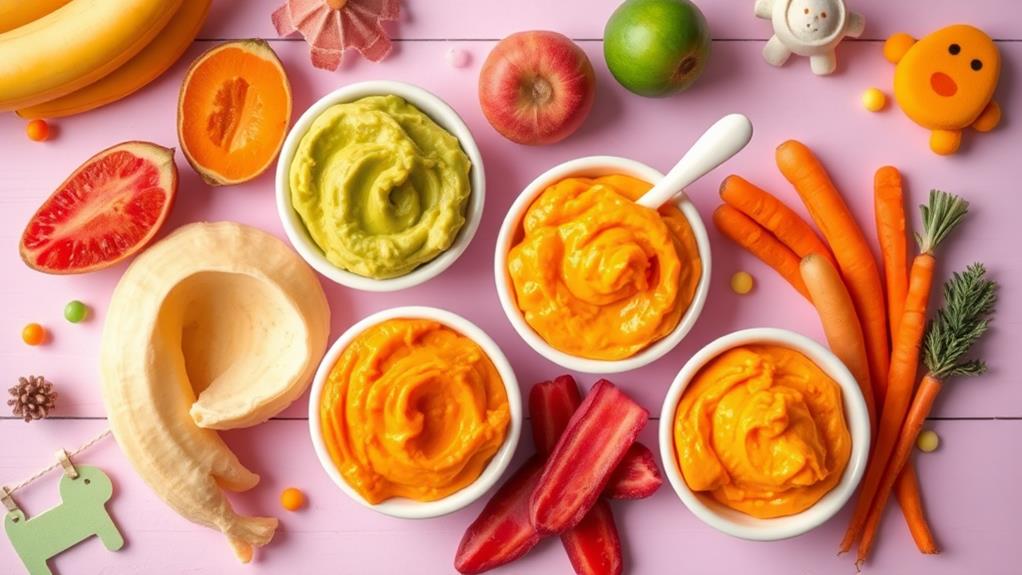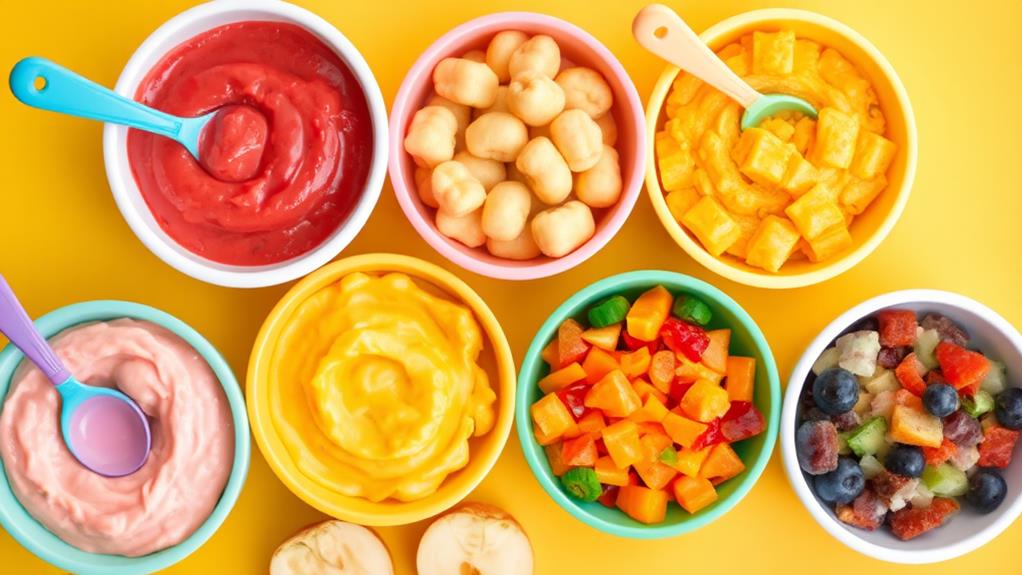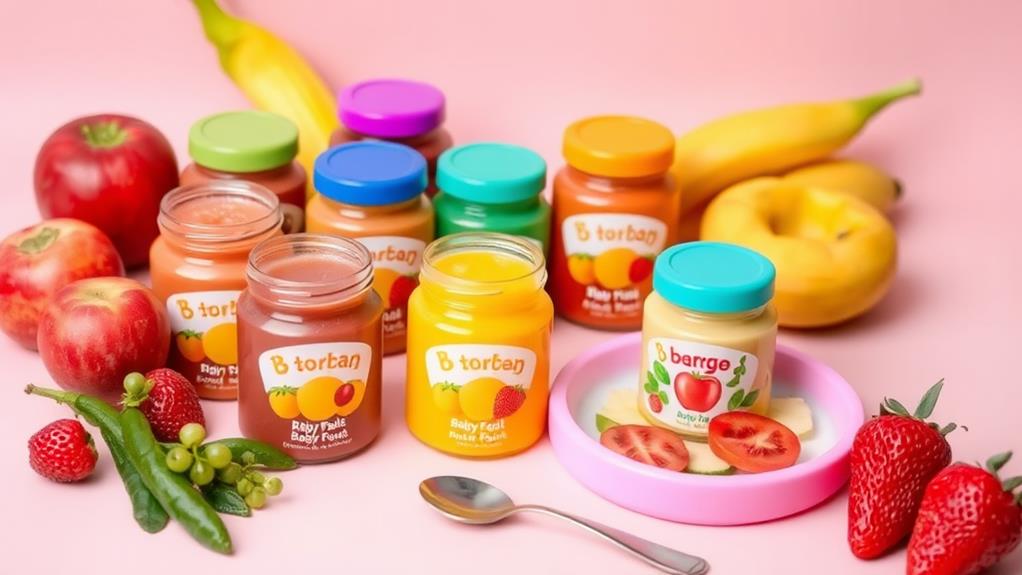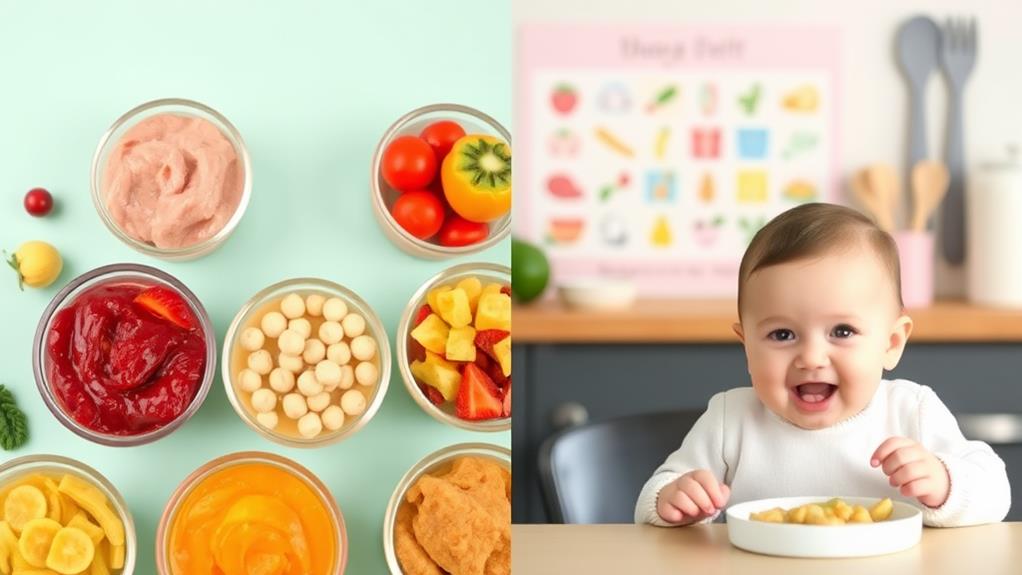7-Month-Old Baby’s Food: Solids, Food Chart And Recipes
At 7 months old, your baby’s introduction to solid foods marks a significant step in their dietary journey. You’ll want to explore a variety of pureed fruits and vegetables, ensuring you meet their nutritional needs while also considering textures that stimulate their developing palate. A well-structured food chart can guide you through this process, presenting options that are both nutritious and appealing. As you navigate this new phase, you’ll discover tips and recipes that make mealtime enjoyable and safe. But what are the best first foods, and how do you monitor for potential allergies?
Understanding Solid Foods

Introducing solid foods to your baby can feel like a significant milestone in their development. You might be excited, nervous, or both! As your little one gets ready for this new adventure, understanding solid foods is essential.
Start by knowing that solids aren’t just about filling up their tummy; it’s about introducing new tastes and textures, too.
At first, you’ll want to focus on pureed fruits and vegetables, like sweet potatoes or apples. These aren’t only gentle on their tiny tummies but also packed with flavor. It’s all about letting them explore! Just be patient; your baby might make funny faces or even spit out food—don’t take it personally.
As you venture into this world of solids, make sure to watch for allergies. Introducing one new food at a time helps you spot any reactions.
Nutritional Needs at 7 Months
At 7 months, your baby’s nutritional needs are evolving as they shift to solid foods. By this age, your little one needs a mix of nutrients to support growth and development. They’ll require iron, protein, healthy fats, and vitamins.
Iron is super important, as it helps in brain development and keeps energy levels up. You can find it in pureed meats, beans, and iron-fortified cereals.
In addition to iron, protein plays an essential role too. It helps build those tiny muscles and tissues.
Don’t forget about healthy fats! Foods like avocado and full-fat yogurt are great options, as they provide essential fatty acids for brain health.
You might also want to think about introducing a variety of fruits and vegetables. They bring vitamins and minerals to the table, plus they can help your baby develop a taste for different flavors.
Remember, the goal is to create a balanced diet while making mealtime fun! So, be prepared for some messy adventures.
Trust me, those sweet potato splatters will be worth it when you see that smile! Keep experimenting, and soon, your baby will be enjoying a colorful plate of tasty treasures.
First Foods to Introduce

Starting your baby’s journey into the world of solid foods can be an exciting adventure. You might feel a mix of joy and nervousness as you think about what to introduce first. Generally, it’s best to start with single-grain cereals or pureed fruits and veggies. Rice cereal is a popular choice and easy to digest. Just mix it with breast milk or formula to get a smooth texture.
Next up, try pureed bananas or avocados. They’re packed with nutrients and have a creamy consistency that most babies love. Sweet potatoes are another fantastic option; they can be steamed, mashed, and offer a natural sweetness that delights tiny taste buds.
Remember to introduce one new food at a time, waiting a few days before adding another. This way, you can watch for any reactions, like rashes or tummy troubles.
And hey, don’t worry if your baby makes funny faces at first—it’s all part of the learning process! Just keep it fun, and enjoy this new phase together. Happy feeding!
Sample Food Chart
A well-structured food chart can be a helpful guide as you navigate your baby’s shift to solid foods.
This chart will give you a variety of options, making mealtime exciting for both you and your little one!
For breakfast, you might start with some mashed banana or pureed oatmeal.
These soft foods are gentle on tiny tummies and full of nutrients.
At lunchtime, consider offering sweet potato puree or finely mashed avocado.
Both options are rich in vitamins and taste great too!
By dinner, you can try some well-cooked and pureed carrots or peas.
It’s essential to introduce new foods slowly, so you can keep an eye out for any reactions.
Don’t forget to serve your baby water in a sippy cup during meals.
It’s a fun way for them to practice drinking!
Texture and Consistency

When introducing solids to your baby’s diet, paying attention to texture and consistency is essential for their development. You want to start with smooth and pureed foods, as they’re easier for your little one to swallow.
Think of it this way: your baby’s tummy is like a tiny blender that needs time to adjust to new textures.
As you progress, you can gradually introduce thicker purees, and even mashed foods. This helps your baby learn to chew and swallow properly. You might even see some funny faces as they try new textures! Don’t worry; that’s just part of the adventure.
Around the six-month mark, you can start adding soft finger foods like small pieces of ripe bananas or steamed veggies. This gives your baby a chance to explore different textures with their little fingers.
Just remember to supervise them closely to avoid any choking hazards.
Balancing smooth and chunky foods keeps mealtime exciting and helps your baby develop important skills. So, embrace the mess, have fun, and enjoy watching your baby discover the world of solid foods!
After all, every little bite is a big step in their journey.
Homemade Baby Food Recipes
Homemade baby food recipes are a fantastic way to guarantee your little one gets fresh, nutritious meals tailored to their taste. Plus, you get to have fun experimenting!
Start with simple purees. For instance, try steaming some sweet potatoes until they’re soft, then mash them up with a fork or blend them for a smoother texture. Sweet potatoes are sweet, creamy, and packed with vitamins!
If your baby’s ready for something new, consider avocado. Just scoop out the flesh, mash it up, and voilà! You’ve got a healthy, buttery treat.
And don’t forget about bananas! They don’t need cooking—just peel, mash, and serve.
You can also mix fruits and veggies. Combine cooked carrots with a bit of apple for a sweet and savory blend. Remember, always introduce new foods one at a time, waiting a few days to watch for any reactions.
Making baby food is super easy, and you can freeze leftovers in ice cube trays for quick meals later.
Store-Bought Options

Many parents find that store-bought baby food offers a convenient and reliable alternative to homemade options. When you’re juggling naps, diaper changes, and everything else, having a jar or pouch of baby food ready to go can be a lifesaver!
These products come in a variety of flavors and textures, making it easy to introduce your little one to new tastes without much fuss.
You’ll notice that most store-bought baby foods are labeled by age, so you can easily pick the right one for your month-old baby. Look for options that are organic and free from artificial additives to guarantee your baby gets the best nutrition possible.
Many brands even offer combinations with fruits and veggies, which can be a great way to sneak in those essential nutrients.
Don’t forget to check the consistency! Some babies prefer smoother textures, while others might be ready for a little more chunkiness as they grow.
And, hey, if you find a flavor that your baby loves, you might just end up stocking up on it! So, grab a few jars, and enjoy the simplicity of store-bought baby food. You’ve got this!
Allergy Considerations
As you introduce solids to your baby, it’s crucial to be aware of potential food allergies. Babies can be sensitive to certain foods, and you want to keep their tiny tummies happy and healthy.
Common allergens include milk, eggs, peanuts, tree nuts, soy, wheat, fish, and shellfish. That sounds like a lot, but don’t worry! You can take it one step at a time.
When starting solids, introduce new foods one at a time and wait about three to five days before adding another. This way, if your baby has a reaction, you’ll know exactly what caused it.
Look out for signs like rashes, hives, or trouble breathing. If you notice anything unusual, call your pediatrician right away.
Tips for Feeding

Feeding your baby can be a joyful yet challenging experience, and having a few handy tips can make it easier. First, start slow. Introduce one new food at a time, so you can see how your little one reacts. Remember, patience is key! It might take several tries before your baby warms up to a new taste.
Don’t forget to make mealtime fun! Use colorful spoons and make silly faces while feeding. This can turn an ordinary lunch into a delightful adventure.
Also, keep the feeding area calm and distraction-free. It’ll help your baby focus on eating instead of everything else going on around them.
Make sure to offer a variety of textures and flavors. This helps your baby develop their palate and discover what they like.
And if things get messy (which they will), don’t stress! A bib and a clean-up cloth will be your best friends.
Lastly, trust your instincts. You know your baby best. If something doesn’t feel right, it’s okay to ask for help or advice. Enjoy these moments together; they grow up fast, and before you know it, they’ll be asking for pizza!
Monitoring Baby’s Reactions
Observing your baby’s reactions during mealtime is key to ensuring they adapt well to new foods. You’ll want to pay close attention to their facial expressions, sounds, and body language. A scrunched-up face might mean they’re not too thrilled about broccoli, while a wide-eyed look could show they’re curious about sweet potatoes.
Watch for any signs of allergies, like rashes or stomach issues. If you notice anything unusual, don’t hesitate to consult your pediatrician. Remember, introducing new foods should feel like an adventure, not a chore!
When trying out different flavors, stick to one new food at a time. This way, you can easily track how your little one reacts. If they love something, celebrate it! If not, don’t worry; just try again later.
Sometimes, babies refuse a food one day and gobble it up the next. It’s all part of their taste-testing phase. Keep it relaxed and fun; laughter can make mealtime more enjoyable.
And hey, don’t forget to snap a picture—those funny expressions are memories you’ll cherish! So, jump in, and enjoy watching your baby discover the world of food!
